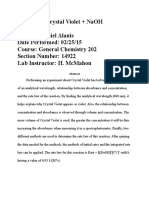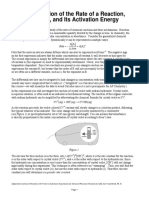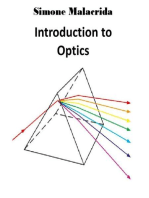Kubelka-Monk Equation (Hunterlab) PDF
Kubelka-Monk Equation (Hunterlab) PDF
Uploaded by
Hameedullah AnsariCopyright:
Available Formats
Kubelka-Monk Equation (Hunterlab) PDF
Kubelka-Monk Equation (Hunterlab) PDF
Uploaded by
Hameedullah AnsariOriginal Title
Copyright
Available Formats
Share this document
Did you find this document useful?
Is this content inappropriate?
Copyright:
Available Formats
Kubelka-Monk Equation (Hunterlab) PDF
Kubelka-Monk Equation (Hunterlab) PDF
Uploaded by
Hameedullah AnsariCopyright:
Available Formats
Insight on Color
Vol. 18, No. 7
The Kubelka-Monk Theory and K/S
What happens to the light that is shined on a sample, as from the light source of a spectrophotometer?
Some is reflected back to the instrument detector, some is absorbed by the colorants in the sample, and
some of it is scattered in all directions within the sample.
.
For samples with opacities greater than 75%, the Kubelka-Monk equation (established in 1931) defines
a relationship between spectral reflectance (R in %) of the sample and its absorption (K) and scattering
(S) characteristics, as follows:
K
[1 - 0.01 R] .
=
S
2[0.01R ]
2
For instance, if spectral reflectance at a given wavelength is 55%, its K/S at that wavelength is
calculated as follows:
Page 1
Copyright 2008
Applications Note
Vol. 18, No. 7
K [1 - 0.01 * 55]
0.45 2
=
= 0.184.
=
S
2[0.01 * 55]
1.1
2
K/S values for the sample measured are calculated separately for each wavelength read. K/S may only
be calculated for measurements made in a reflectance mode. K/S is a spectral data type, meaning it is
calculated and displayed for each measurement wavelength in the Spectral Data Table of your
EasyMatch QC or Universal software. K/S grows to infinity as reflectance decreases to zero, so the
software may not display a K/S value for a particular wavelength or wavelengths if the reflectance is
very low (i.e., less than 0.05%).
The Kubelka-Monk equation is useful when formulating colors for industries such as textiles, paper, and
coatings. For these applications, it is assumed that the scattering (S) of a dye or pigment depends on the
properties of the substrate or opacifier, while the absorption (K) of light depends on the properties of the
colorant. The Kubelka-Monk equation is roughly linear with respect to colorant concentration, as
follows:
K/S = kC
where
C = concentration of the colorant
k = a constant.
The Kubelka-Monk theory further extends to mixtures of colorants and asserts that the K/S value for a
mixture of colorants is the sum of the K/S values of the individual colorants, as follows:
(K/S)mixture = a(K/S)colorant 1 + b(K/S)colorant 2 + c(K/S)colorant 3 . . . + (K/S)base
where
a, b, c, etc. are the concentrations of the corresponding colorants.
This assumption can be practically applied when the appearance of finished materials must be related to
the kinds and amounts of colorants put into them. It is what makes computer color formulation and
color matching (as opposed to visual trial-and-error methods) possible. K/S values for all the individual
colorants are first determined and are then stored in the computer for use any time those colorants are
included in a mixture.
Bibliography
Berns, Roy S., Billmeyer and Saltzmans Principles of Color Technology, New York: John Wiley &
Sons, 2000.
Hunter, Richard S. and Harold, Richard W., The Measurement of Appearance, New York: Wiley, 1987.
Kubelka, P. and Monk, F., Z tech. Physik, 12, 593 (1931).
Page 2
Copyright 2008
Applications Note
Vol. 18, No. 7
For Additional Information Contact:
Technical Services Department
Hunter Associates Laboratory, Inc.
11491 Sunset Hills Road
Reston, Virginia 20190
Telephone: 703-471-6870
FAX: 703-471-4237
www.hunterlab.com
03/08
Page 3
Copyright 2008
You might also like
- IB Chemistry HL Internal AssessmentDocument14 pagesIB Chemistry HL Internal AssessmentZinzan Gurney100% (2)
- Understanding JAYPAK Plastic Paints Basic Recipe Prediction ModelDocument39 pagesUnderstanding JAYPAK Plastic Paints Basic Recipe Prediction ModelManish ParulNo ratings yet
- 106 Expt2V-KineticsII PDFDocument8 pages106 Expt2V-KineticsII PDFlumengentiunNo ratings yet
- Bandpay2018 Article MathematicalAndEmpiricalEvaluaDocument15 pagesBandpay2018 Article MathematicalAndEmpiricalEvaluawil tegoNo ratings yet
- Calculating Correlated Color Temperatures Across The Entire Gamut of Daylight and Skylight ChromaticitiesDocument7 pagesCalculating Correlated Color Temperatures Across The Entire Gamut of Daylight and Skylight ChromaticitiesdeejjjaaaaNo ratings yet
- 00 Kinetics CVLabDocument13 pages00 Kinetics CVLabRyan PanNo ratings yet
- Derivation of Plancks Formula Radiation Chapter10Document14 pagesDerivation of Plancks Formula Radiation Chapter10TewodrosNo ratings yet
- 8 - Cerenkov Radiation From 40k BJC, V.29, n.1, 2012Document7 pages8 - Cerenkov Radiation From 40k BJC, V.29, n.1, 2012Bolivian Journal of ChemistryNo ratings yet
- Experiment 2: Investigation Into The Kinetic Behaviour of Aqueous Crystal Violet SolutionsDocument15 pagesExperiment 2: Investigation Into The Kinetic Behaviour of Aqueous Crystal Violet SolutionsasdasNo ratings yet
- CHEM123 Exp 11 Lab ReportDocument2 pagesCHEM123 Exp 11 Lab Reportanonstudent415No ratings yet
- Beers Law NotesDocument5 pagesBeers Law NotesJerome GironNo ratings yet
- Submitted by Parveen SharmaDocument9 pagesSubmitted by Parveen Sharmasony7860No ratings yet
- What Is The True Kramers-Kronig Transform?Document3 pagesWhat Is The True Kramers-Kronig Transform?Ali AddieNo ratings yet
- SpectrosDocument58 pagesSpectrospaoloobiasNo ratings yet
- Crystal Violet Kinetics LabDocument3 pagesCrystal Violet Kinetics LabBhavan PrasaadNo ratings yet
- Sample With Specific Details For The Formal Report RevDocument16 pagesSample With Specific Details For The Formal Report RevAnyohotodayNo ratings yet
- Calculating SpectraDocument16 pagesCalculating Spectraziggie_lenzNo ratings yet
- Vertudazo, O. (ProbSet IR Spectroscopy)Document10 pagesVertudazo, O. (ProbSet IR Spectroscopy)Olsen VertudazoNo ratings yet
- Refractive IndexDocument5 pagesRefractive IndexAhmed NabilNo ratings yet
- Anthony, Julia, and Gloria - Lab 11Document11 pagesAnthony, Julia, and Gloria - Lab 11Anthony HowerNo ratings yet
- Can J Chem Eng - 2018 - Rocha - Experimental Methods in Chemical Engineering Ultraviolet Visible Spectroscopy UV VisDocument6 pagesCan J Chem Eng - 2018 - Rocha - Experimental Methods in Chemical Engineering Ultraviolet Visible Spectroscopy UV VisWeronika LaryszNo ratings yet
- Crystal VioletDocument10 pagesCrystal VioletTaniya GuptaNo ratings yet
- Lab #1: Absorption Spectra of Conjugated Dyes: E E E EDocument5 pagesLab #1: Absorption Spectra of Conjugated Dyes: E E E EIreneVeladoNo ratings yet
- Exp. 2 c230 S - 07 Keq of FeSCNDocument10 pagesExp. 2 c230 S - 07 Keq of FeSCNdenciopoNo ratings yet
- How To Calculate A Theoretical Limit For DiffusionDocument2 pagesHow To Calculate A Theoretical Limit For DiffusionMaxNo ratings yet
- Lab 2 KineticsDocument9 pagesLab 2 KineticsAlec PartowNo ratings yet
- The Energetics of Micelle FormationDocument9 pagesThe Energetics of Micelle FormationNoel LamNo ratings yet
- Chem 137.1 - Exer 1 PostlabDocument15 pagesChem 137.1 - Exer 1 PostlabGerry Mark Gubantes100% (1)
- Determination of Copper (II) Concentration by Colorimetric MethodDocument5 pagesDetermination of Copper (II) Concentration by Colorimetric MethodBulawan LaNeref Oremse100% (2)
- Geusebroek ECCG2002 ADocument5 pagesGeusebroek ECCG2002 AmohitNo ratings yet
- Jansen Ap Chem PDFDocument57 pagesJansen Ap Chem PDFMarko MihokovićNo ratings yet
- Speeding Up Cosmological Boltzmann CodesDocument7 pagesSpeeding Up Cosmological Boltzmann CodesWilliam AlgonerNo ratings yet
- Chem Lab 7sDocument7 pagesChem Lab 7sChantelle LimNo ratings yet
- Soufiani 1994Document11 pagesSoufiani 1994a.laoutiNo ratings yet
- Lyons Bartlett MHC 1Document9 pagesLyons Bartlett MHC 1mikelyonsNo ratings yet
- A Theoretical-Experimental Comparison of CdSe QuanDocument6 pagesA Theoretical-Experimental Comparison of CdSe Quanramy thaerNo ratings yet
- Experiment 10-Spectrophotometric MethodsDocument6 pagesExperiment 10-Spectrophotometric MethodsMarc DiongcoNo ratings yet
- The Backscattering of Gamma Radiation From Plane Concrete WallsDocument22 pagesThe Backscattering of Gamma Radiation From Plane Concrete WallsHatim ElNo ratings yet
- Lab 5Document5 pagesLab 5Hong Loi LamNo ratings yet
- Let There Be Light!Document10 pagesLet There Be Light!Arthur ThiesenNo ratings yet
- Ch34 ISM 070623Document56 pagesCh34 ISM 070623Ian GravesNo ratings yet
- AtomicreviewDocument4 pagesAtomicreviewHahaha YesNo ratings yet
- Evaluating Experiment With Computation in Physical Chemistry: The Particle-In-A-Box Model With Cyanine DyesDocument12 pagesEvaluating Experiment With Computation in Physical Chemistry: The Particle-In-A-Box Model With Cyanine DyesAlejandra DíazNo ratings yet
- Chemistry Lab ReportDocument18 pagesChemistry Lab Reportapi-341785642No ratings yet
- Lesson Plan 3Document8 pagesLesson Plan 3sakhi dewaniNo ratings yet
- Lab2The Equilibrium Constant For A Complex IonDocument8 pagesLab2The Equilibrium Constant For A Complex IonPhan NguyễnNo ratings yet
- Uv VisibleDocument13 pagesUv VisiblebushraqadriNo ratings yet
- CIC 2021 Art00039 Gregory-HighDocument6 pagesCIC 2021 Art00039 Gregory-HighRog96No ratings yet
- Spectrophotometric Determination of The Equilibrium Constant of A ReactionDocument8 pagesSpectrophotometric Determination of The Equilibrium Constant of A ReactionWilfredo LlanaNo ratings yet
- 12 Determination of The Order of A Chemical Reaction and Its Activation EnergyDocument25 pages12 Determination of The Order of A Chemical Reaction and Its Activation EnergyZamri FadilahNo ratings yet
- A Brief Overview of Existence Results and Decay Time Estimates For A Mathematical Modeling of Scintillating CrystalsDocument40 pagesA Brief Overview of Existence Results and Decay Time Estimates For A Mathematical Modeling of Scintillating CrystalsFabrizio DavìNo ratings yet
- 2 Visible Spectroscopy - GoodDocument7 pages2 Visible Spectroscopy - GoodOmSilence2651No ratings yet
- Assignment_1 solutionsDocument2 pagesAssignment_1 solutionskishorNo ratings yet
- Lecture IDocument50 pagesLecture INofrizalNo ratings yet
- Electronic Spectra of Cyanine Dyes: A Particle in The Box ModelDocument6 pagesElectronic Spectra of Cyanine Dyes: A Particle in The Box ModelMurad AlDamenNo ratings yet
- Electrochemical Processes in Biological SystemsFrom EverandElectrochemical Processes in Biological SystemsAndrzej LewenstamNo ratings yet
- Electron Beam-Specimen Interactions and Simulation Methods in MicroscopyFrom EverandElectron Beam-Specimen Interactions and Simulation Methods in MicroscopyNo ratings yet
- Color Appearance Model: Understanding Perception and Representation in Computer VisionFrom EverandColor Appearance Model: Understanding Perception and Representation in Computer VisionNo ratings yet
- Difference Between Dyes and PigmentsDocument5 pagesDifference Between Dyes and PigmentsHameedullah Ansari100% (1)
- Participative Management: SynergyDocument17 pagesParticipative Management: SynergyHameedullah AnsariNo ratings yet
- Manufacturing Processes For Synthetic FibersDocument14 pagesManufacturing Processes For Synthetic FibersHameedullah AnsariNo ratings yet
- Colour and Fastness of Natural DyesDocument10 pagesColour and Fastness of Natural DyesHameedullah AnsariNo ratings yet
- Energy Management in Textile IndustryDocument5 pagesEnergy Management in Textile IndustryHameedullah AnsariNo ratings yet
- Eco - Labeling: Name of IndustryDocument23 pagesEco - Labeling: Name of IndustryHameedullah AnsariNo ratings yet
- Marzoli Vouk: Draw FramesDocument22 pagesMarzoli Vouk: Draw FramesHameedullah AnsariNo ratings yet
- 7146 22783 2 PBDocument10 pages7146 22783 2 PBfirmansyaaah3378No ratings yet
- Installation Qualification Protocol For Walk - in Incubator System Name: Walk - in Incubator Document No.: NECPL/IQ/11220I/1 Page No.: 1 of 25Document25 pagesInstallation Qualification Protocol For Walk - in Incubator System Name: Walk - in Incubator Document No.: NECPL/IQ/11220I/1 Page No.: 1 of 25vipin100% (1)
- Government of Uttar PradeshDocument81 pagesGovernment of Uttar PradeshUmesh MishraNo ratings yet
- Padeepz GE3251 Question PapersDocument10 pagesPadeepz GE3251 Question PapersSaidu HomeNo ratings yet
- Department of Education: Division of Negros OrientalDocument10 pagesDepartment of Education: Division of Negros OrientalAbell Rafales MamigoNo ratings yet
- Li Et Al., 2017 PDFDocument13 pagesLi Et Al., 2017 PDFT BranizNo ratings yet
- MagicDocument5 pagesMagicpceautohodNo ratings yet
- GTZ Report - English (Edited)Document102 pagesGTZ Report - English (Edited)no1suspektNo ratings yet
- WritingDocument157 pagesWritingKha My NguyenNo ratings yet
- How Champions Think (Workshop)Document4 pagesHow Champions Think (Workshop)olha100% (1)
- I-ENG-WEEK-3 Day 2Document12 pagesI-ENG-WEEK-3 Day 2Cheeny De GuzmanNo ratings yet
- An Outlook of Malaysian Biomass Industry Commercialisation Perspectives and ChallengesDocument19 pagesAn Outlook of Malaysian Biomass Industry Commercialisation Perspectives and ChallengesHow Bing ShenNo ratings yet
- FN Assign 2Document2 pagesFN Assign 2Chris ZaynNo ratings yet
- Template Download Utility: Luis Ortega US Currency Template ManagerDocument19 pagesTemplate Download Utility: Luis Ortega US Currency Template ManagercrazylcmcNo ratings yet
- CERN Initial Letter For Yr 12Document2 pagesCERN Initial Letter For Yr 12AlexFryNo ratings yet
- GJU MBA 4th Sem NotesDocument41 pagesGJU MBA 4th Sem NotesKapil Vats100% (3)
- Sustainable Development Goals Coca ColaDocument19 pagesSustainable Development Goals Coca ColaFelipe Velasquez Arango50% (2)
- Stage II SynopsisDocument4 pagesStage II SynopsisShubham KhuranaNo ratings yet
- Jadwal PJJ Sma Advent XV Ciracas 2021/2022Document4 pagesJadwal PJJ Sma Advent XV Ciracas 2021/2022Gerald Ryan TriyonoNo ratings yet
- Term Paper Part 1: Identifying The Problems in BME 14: Systems Thinking, Analysis and DesignDocument5 pagesTerm Paper Part 1: Identifying The Problems in BME 14: Systems Thinking, Analysis and DesignFrim CalamnoNo ratings yet
- My Grandmother's New Smartphone: Social Media and EducationDocument3 pagesMy Grandmother's New Smartphone: Social Media and EducationSvetlanaNo ratings yet
- 2021 WTS 12 Maths T2 CampDocument38 pages2021 WTS 12 Maths T2 Campss5543216880No ratings yet
- Type of High Rise BuildingDocument31 pagesType of High Rise BuildingsolarstuffNo ratings yet
- 2050 Lab 3Document2 pages2050 Lab 3썸머No ratings yet
- Civic and Moral Package ViDocument4 pagesCivic and Moral Package Viyusuphkhatibu123No ratings yet
- English Lord of The Flies CharactersDocument1 pageEnglish Lord of The Flies CharactersjusykestremblayNo ratings yet
- Opman ReviewerDocument2 pagesOpman ReviewerArkhie DavocolNo ratings yet
- ICC Judges - QP PDFDocument5 pagesICC Judges - QP PDFN FNo ratings yet
- APA in EnglishDocument2 pagesAPA in EnglishDr. Sashibhusan MishraNo ratings yet
- Global Ocean Current Energy Assessment An Initial LookDocument9 pagesGlobal Ocean Current Energy Assessment An Initial Lookmansoor2No ratings yet
































































































